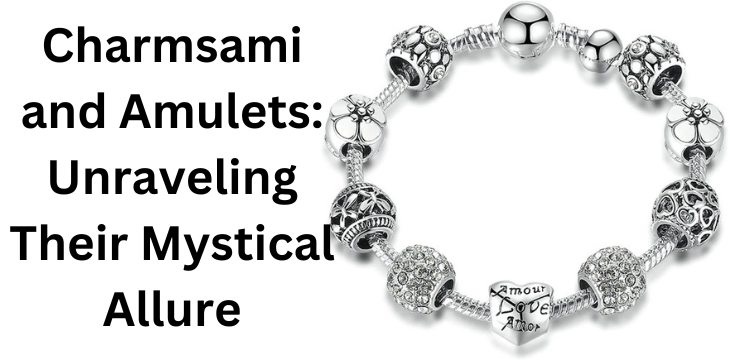Table OF Contents
Table Of The Article
- Introduction to Charms and Amulets
- Definition and History
- Cultural Significance
- Types of Charms and Amulets
- Religious Charms
- Lucky Charms
- Protection Amulets
- Love Charms
- How Charms and Amulets Work
- Belief and Intention
- Symbolism and Energy
- Popular Charms and Amulets Across Cultures
- Hamsa Hand
- Four-Leaf Clover
- Evil Eye
- Dreamcatcher
- Choosing and Using Charms and Amulets
- Personal Connection
- Proper Care and Maintenance
- The Modern Appeal of Charms and Amulets
- Fashion Trends
- New Age Spirituality
- Conclusion
Introduction to charmsami and Amulets
Definition and History
charmsami and amulets are objects imbued with supernatural powers, believed to bring good fortune, ward off evil, or provide protection to their wearer. The tradition of wearing or carrying such talismans dates back thousands of years, with roots in various religious and cultural practices.
Cultural Significance
Across civilizations, charmsami and amulets have held immense cultural significance. From ancient Egypt’s scarab beetles symbolizing resurrection to Celtic charms carved with intricate knots representing eternal life, these artifacts reflect diverse belief systems and traditions.
Types of charmsami and Amulets
Religious charmsami
Many religious faiths incorporate charmsami and amulets into their practices. Examples include Christian crucifixes, Hindu yantras, and Buddhist prayer beads, each carrying spiritual significance and serving as a conduit for divine blessings.
Lucky charmsami
Lucky charmsami are perhaps the most ubiquitous type of talisman, believed to attract good fortune and prosperity. Common examples include horseshoes, four-leaf clovers, and lucky coins, cherished for their supposed ability to bring luck into one’s life.
Protection Amulets
Protection amulets are designed to safeguard the wearer from harm or negative energies. These may include symbols such as the evil eye, pentagrams, or runes, believed to create a barrier against malevolent forces.
Love charmsami
Love charmsami, often associated with romance and relationships, are intended to enhance attraction, foster intimacy, or mend broken hearts. From heart-shaped pendants to engraved lockets, these charms symbolize love’s enduring power.
How charmsami and Amulets Work
Belief and Intention
Central to the efficacy of charmsami and amulets is the power of belief. It is the faith and intention of the wearer that imbue these objects with their purported magical properties, influencing outcomes and experiences.
Symbolism and Energy
Many charmsami and amulets derive their potency from symbolism and energy. Whether through sacred symbols, natural materials, or blessed artifacts, these talismans are believed to harness mystical energies that resonate with the wearer’s desires.
Popular charmsami and Amulets Across Cultures
Hamsa Hand
The Hamsa hand, originating from Middle Eastern and North African cultures, is a symbol of protection and good fortune. Depicting an open palm with an eye in the center, it wards off evil and invites blessings.
Four-Leaf Clover
The four-leaf clover is an age-old symbol of luck and prosperity, with each leaf representing faith, hope, love, and luck. Finding a genuine four-leaf clover is considered a rare and fortunate occurrence.
Evil Eye
The evil eye, prevalent in Mediterranean and Middle Eastern cultures, is believed to ward off curses and malevolent intentions. Amulets featuring the eye symbol are worn to deflect negativity and promote good fortune.
Dreamcatcher
Originating from Native American traditions, the dreamcatcher is a protective talisman believed to filter out negative dreams and promote positive energies. It consists of a woven net adorned with sacred feathers and beads.
Choosing and Using charmsami and Amulets
Personal Connection
When selecting a charm or amulet, it is essential to choose one that resonates with your beliefs and intentions. Whether inherited, gifted, or purchased, the significance of the talisman lies in the personal connection forged between the wearer and the object.
Proper Care and Maintenance
To maximize the efficacy of charmsami and amulets, proper care and maintenance are crucial. Regular cleansing rituals, charging under the moonlight, or consecrating with sacred oils can help restore and enhance their mystical properties.
The Modern Appeal of charmsami and Amulets
Fashion Trends
In recent years, charmsami and amulets have experienced a resurgence in popularity, transcending their traditional roles as spiritual artifacts. They are now embraced as fashion accessories, adorning jewelry, handbags, and clothing with symbolic significance.
New Age Spirituality
Within the realm of New Age spirituality, charmsami and amulets play a central role in rituals, ceremonies, and manifestation practices. Whether used for meditation, energy healing, or spiritual protection, these mystical tools offer seekers a tangible connection to the divine.
Conclusion
charmsami and amulets continue to captivate the human imagination, serving as tangible symbols of faith, hope, and protection. Across cultures and throughout history, these mystical artifacts endure, offering comfort, guidance, and a touch of magic to those who believe.
FAQs
- Are charmsami and amulets scientifically proven to work? While there is no scientific evidence to support the supernatural properties of charms and amulets, their efficacy is often attributed to the power of belief and intention.
- How do I choose the right charm or amulet for me? Trust your instincts and select a talisman that resonates with your personal beliefs, intentions, and desires.
- Can I wear multiple charmsami and amulets together? Yes, you can mix and match charms and amulets based on your preferences and intentions. Just ensure that each talisman aligns with your energy and goals.
- Do charmsami and amulets need to be cleansed or charged? It is recommended to periodically cleanse and charge your charmsamii and amulets to maintain their potency and effectiveness.
- Can I give charmsami and amulets as gifts? Yes, charms and amulets make meaningful and thoughtful gifts, especially when chosen with the recipient’s beliefs

